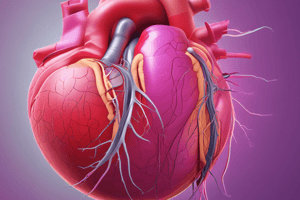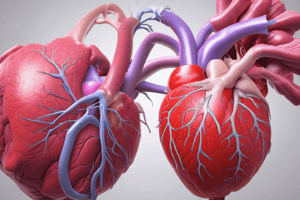Podcast
Questions and Answers
Which type of pericarditis is characterized by a life-threatening condition requiring immediate medical attention?
Which type of pericarditis is characterized by a life-threatening condition requiring immediate medical attention?
- Cardiac Tamponade (correct)
- Constrictive Pericarditis
- Pericardial Effusion
- Chronic or Recurrent Pericarditis
What is the primary function of the pericardium in relation to cardiac health?
What is the primary function of the pericardium in relation to cardiac health?
- It facilitates electrical conduction within the heart.
- It acts as a barrier against blood clots.
- It regulates the heart's pumping action.
- It provides lubrication for the heart's movement. (correct)
Which of the following manifestations is commonly associated with acute pericarditis?
Which of the following manifestations is commonly associated with acute pericarditis?
- Dizziness and fainting
- Severe chest pain that improves when sitting up (correct)
- Pulsating swelling in the abdomen
- Fever and muscle soreness
In which situation is the pathophysiology of pericarditis primarily caused by an infectious agent?
In which situation is the pathophysiology of pericarditis primarily caused by an infectious agent?
Which of the following differentiates constrictive pericarditis from other types?
Which of the following differentiates constrictive pericarditis from other types?
Which of the following is NOT a characteristic symptom of pericarditis?
Which of the following is NOT a characteristic symptom of pericarditis?
What is the main reason for focusing on pain relief in the treatment of pericarditis?
What is the main reason for focusing on pain relief in the treatment of pericarditis?
What does a significant difference in the systolic BP measurements during the pulsus paradoxus test indicate?
What does a significant difference in the systolic BP measurements during the pulsus paradoxus test indicate?
In the context of chronic congestive pericarditis, what does an increased white blood cell (WBC) count typically indicate?
In the context of chronic congestive pericarditis, what does an increased white blood cell (WBC) count typically indicate?
Which of the following assessments would likely show ST-segment elevation in a patient with pericarditis?
Which of the following assessments would likely show ST-segment elevation in a patient with pericarditis?
Which sign is most indicative of cardiac tamponade?
Which sign is most indicative of cardiac tamponade?
What is a primary non-surgical intervention for endocarditis?
What is a primary non-surgical intervention for endocarditis?
Which is NOT a risk factor for decreased cardiac output related to pericarditis?
Which is NOT a risk factor for decreased cardiac output related to pericarditis?
Which criterion is classified as a major criterion in the diagnosis of infective endocarditis?
Which criterion is classified as a major criterion in the diagnosis of infective endocarditis?
In which situation might pericardiocentesis be indicated?
In which situation might pericardiocentesis be indicated?
What is a common physical assessment finding in patients with endocarditis?
What is a common physical assessment finding in patients with endocarditis?
Which nursing diagnosis reflects a concern about potential infection in endocarditis patients?
Which nursing diagnosis reflects a concern about potential infection in endocarditis patients?
What symptom is commonly monitored for in patients with endocarditis to assess heart failure?
What symptom is commonly monitored for in patients with endocarditis to assess heart failure?
Flashcards are hidden until you start studying



